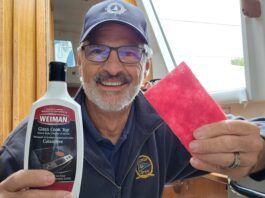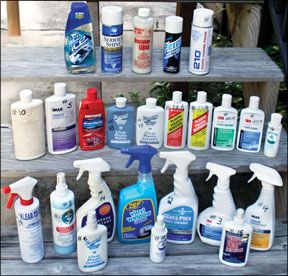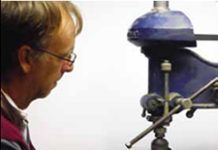Making an Anodized Mast Look Like New
Have you done any research on the best means of cleaning an aluminum mast? Im having other work done to mine and thought it would be a good time for a cleaning.
Long-term Testing Clear Vinyl
Our long-term test of clear vinyl and clear-vinyl treatments includes environmental outdoor tests with controls, as well as some real-world testing on one of our test boats.
Treating Vinyl for Long Life
Vinyl protection is about the long run. In the Practical Sailor January 2014 issue, we reported on the performance of a host of clear-vinyl waxes and cleaners, as well as several different clear-vinyl window materials, after testing them for four months on panels. This report is the two-year update on the long-term test of those products, and already the first failures have appeared.
Cleaning the Holding Tank
Weve noticed an odor and a buildup of caked-on solids in the holding tank. My thought is to fill the holding tank with fresh water and the right additive, then let that slosh around underway, and then pump it out. What do you suggest for an additive?
Fighting Mildew, Mold, and Lichen
Most boat owners regard their boat as a living, breathing thing, but when real living things-especially the microscopic variety-move aboard and start occupying large swaths of damp real estate, its time to draw the line. Weve done a series of reports on mildew in past articles, but those black spots on the deck, lines, and canvas probably arent mildew. Mildew and mold require darkness, and even the shaded areas on deck are too well lit. Those spots are more likely black algae and lichens, the latter a symbiotic combination of algae and fungus.
Searching for Spray Shine
Is there a quick, easy way to get a glossy shine on the deck and topsides between the grueling wax-and-buff efforts? To find out, testers launched a search for affordable spray waxes-liquid waxes designed for speedy touchups rather than full-tilt compounding-and-waxing jobs. We specifically sought out spray-on products that offer a glossy finish and some surface protection and that are applied after rubbing compounds, fillers, waxes, and polishes.
Restoring Clear-vinyl Windows
Clear vinyl dodger windows, through which we keep watch, are annoying tattle tales, recording and announcing every bit of rough handling and neglect. They burn in the sun. They bleed plasticizers, turning yellow and sticky. And unlike mildew in the cockpit or an upholstery stain, we can't simply ignore their flaws by turning our heads.
Restoring Vinyl Windows: DIY or Hire a Pro?
If your vinyl dodger windows are more than five to seven years old and looking tired but your canvas is still looking good, its likely time to breathe some new life into them. Vinyl-window restoration can remove surface oxidation, plasticizer residue, imbedded dirt, scuffs, and very shallow scratches; it also can provide a durable coating to seal the surface, which will be more porous after buffing. Smaller window restorations can be handled by the do-it-yourselfer, but for big-or particularly gnarley-jobs, you may want to consider hiring someone to do it for you.
Heavy-Duty Rubbing Compounds
Gelcoat provides a fiberglass boat with a hard, water-resistant protective shell. When new, its polished and waxed to a bright shine, but after a few years of facing the elements-especially damaging UV rays-gelcoat will begin to oxidize and turn into a dull, chalky film on the surface. There are a few ways to remedy an oxidation problem (see Tips & Techniques), but for this article, we focused on coarse and medium-coarse rubbing compounds, which can be buffed on to remove the chalky layer and fine scratches. The tests evaluated ease of use, ability to remove oxidation and scratches, and whether they left swirl marks; testers also considered price, availability, and eco-friendliness.
Tired Daysailer Hull Serves as Test Platform
Practical Sailor tested the compounds on the badly oxidized hull of a neglected 1974 ODay Javelin daysailer that has been stored uncovered in the Florida sun and salt air for years. Formerly the platform for gelcoat restorer and wax tests, the Javelins once dark-blue hull had degraded into a chalky, light blue mess.

















































